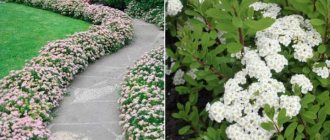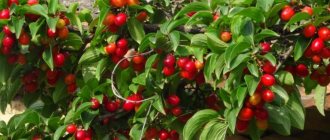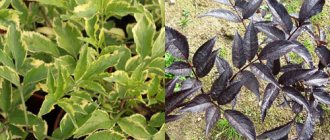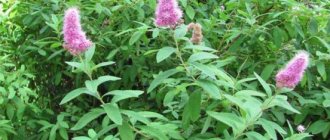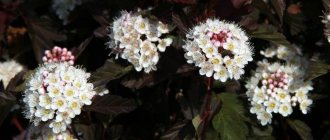Description of the ornamental spirea shrub
To know how to grow spirea, you first need to read its description.
Spirea, or, as it is also popularly called meadowsweet, is a genus of beautifully flowering ornamental shrubs. It is thanks to the winding shoots that the shrub got its name, because translated from ancient Greek “spirea” sounds like “bend” or “flexibility”. This shrub is completely unpretentious. This genus of plants has about 100 varieties growing in various habitats: steppes, forest-steppes and even semi-deserts. Shrub varieties are distinguished by their decorative properties and ability to withstand even the lowest temperatures.
Spiraea can be either a dwarf plant, no more than 15 cm high, or tall shrubs, reaching 2-2.5 m. The roots lie shallow and have a fibrous appearance. The branches of a bush can either spread along the ground or shoot upward. They have a light or dark brown tint. The bark begins to flake off with age. It blooms with small flowers in large quantities.
The inflorescences of the shrub also vary: they can be panicles, spikelets or pyramids. The color of the flowers depends on the variety and type of plant. It can be white, lilac, bright crimson. Also, depending on the variety of shrub, the inflorescences will be arranged differently.
Some of them cover the entire stem and shoot of the plant, while others settle only at the ends of the branches. The plant can be propagated by cuttings, layering or seeds. It is also possible to divide the bush to obtain a new plant.
This shrub is perfect for hedges and group plantings to create a complete composition. It can also be used for a “living carpet”. But despite this, when planted alone, the spirea shrub looks no worse.
The plant's habitat extends throughout Eurasia. Most often, you can find it near large bodies of water or thickets of wild bushes.
The breeding and cultivation of shrubs by individual species began back in the Middle Ages. The large-flowered species can easily be considered the favorite of all gardeners. Its long flowering has won the hearts of many people, because it continues from May until the very end of July. Often the bush blooms twice in a season, but the second flowering is not so abundant.
Based on the time of flowering, this plant is divided into two subgroups: spring-flowering and summer-flowering. The first most often includes shrubs whose flowers are white and appear on old shoots. The second subgroup is characterized by various shades: pink, lilac, crimson, and flowers appear on new branches.
Care for each subgroup is different. If the first type can be pruned only in the spring, then the second group can be pruned immediately after flowering.
Shrubs are unpretentious to soil, prefer bright places and tolerate frost well. Growing spirea is possible even near roads: the plants tolerate gas pollution well. The shrub grows quickly; you can observe its flowering already in the 3rd year.
Look at the photo of the ornamental spirea shrub:
Description
Spiraea or meadowsweet belongs to the Rosaceae family. This shrub is widely used in landscape design, because it can decorate any garden, yard, flower garden, and also become part of attractive compositions in combination with other plants.
Spiraea japonica is the Latin name for the Japanese dwarf or lilliputian spirea, characterized by a miniature spherical bush. This type of plant is a summer flowering plant. From June to August, beautiful inflorescences of small flowers appear on its shoots. They can be soft pink and red.
Did you know? Spiraea shoots contain salicin glycoside, which can be converted into aspirin.
The leaves of this type of spirea are also very beautiful. Most often they are colored in various shades of yellow, and depending on the time of year they can acquire a slightly reddish or orange color.
Due to the fact that this plant adapts well to different climatic conditions and is unpretentious in choosing soil for growth, it is very popular. And, despite the name, this type of spirea grows not only in Japan, but also in many other countries around the world.
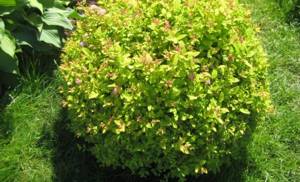
How to grow spirea: planting a bush
Despite its unpretentiousness to the soil, planting and caring for spirea shrubs has several subtleties and nuances:
- The ideal soil for the plant will be leaf and turf soil. The composition of the soil should be close to this: 1 part peat, 1 part sand, 2 parts earth;
- The importance of drainage is often underestimated. It prevents stagnation of water in the roots, which can lead to serious diseases. Broken brick or crushed stone is suitable for it;
- the hole should be dug 1/3 larger than the planting earthen ball;
- It is necessary to plant at a depth of more than half a meter. The horse neck of the bush should be visible on the surface;
- The ideal time for this would be cloudy weather. Rain will also do. This should be done in early autumn;
- as neighbors, the plant will prefer conifers, for example, juniper and thuja.
Now we will talk in detail about how to plant spirea at different times of the year.
How to plant and replant spirea in spring
Planting in spring is possible only for summer-flowering shrubs. The main thing when planting a shrub is that it needs to be done before the foliage appears. The root system should not be dried out; learn this if you buy seedlings. The shoots should also look healthy: be flexible and have several buds. Before planting, the plant must be “lightened”. So, if the roots of the seedlings are damaged, then it is worth slightly trimming the upper part of the plant - the shoots. Later in the article we will tell you how to prune spirea in the spring. If, on the contrary, the roots are abundant, then it is worth trimming them.
There are times when the roots dry out when storing seedlings. To prevent unpleasant consequences, soak them in water and only then plant them.
We will tell you how to plant and replant spirea in order to cause the least harm to the shrub.
As mentioned earlier, spirea is an unpretentious plant, however, if you prefer to admire long and massive flowering, then it is worth providing the shrub with the best conditions.
The landing site should be chosen on the sunny side, with fertile soil. Teach that the roots of a shrub can grow very quickly, which significantly increases the space occupied by the shrub.
When planting a plant, dig a vertical hole 1/3 larger than the size of the planting ball. After which, leave it for several days. Be sure to provide a drainage layer (10-15 cm). Then, mix leaf soil, sand and peat at a ratio of 2:1:1, and pour this mixture into the hole. Lower the bush, straighten the roots and cover it with fertile soil so that the neck remains on the surface. Compact well. After planting, the plant must be watered abundantly and peat mulch must be made.
Reproduction
Since gray spirea is of hybrid origin, it is propagated not by seeds, but by vegetative methods - layering and cuttings.
Growing spirea Wangutta - planting and care
The cuttings are cut after flowering and rooted under a transparent cap in a substrate of coarse river sand and peat. The soil in the container should be kept moist all the time. To be safe, before planting, keep the cuttings for 16 hours in a growth stimulator - a solution of indolylbutyric acid. Or let them stand in water to which a drop of Epin has been added, then powder the lower sections with Kornevin and only after that plant the cuttings in the greenhouse. The cuttings that have grown roots are planted in open ground, but in the first winter they must be covered with dry foliage.
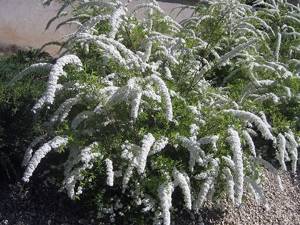
Since the branches of spirea are flexible, you can get a new plant in another way. How to propagate gray spirea by layering? In the spring, bend the low-growing spirea shoot to the ground and place the part of it that is closer to the top in a pre-made furrow, leaving the top above the surface and pinching it. Secure the branch in this position and fill the furrow with fertile soil. Water the cuttings all summer, and cover them with dry leaves in the fall. Next spring, separate the rooted branch from the mother bush and plant it.
- Phacelia: when and how to sow, cultivation and benefits
How to plant spirea correctly in the fall
Unlike the spring season, both groups of plant varieties can be planted in the fall. Most often, they are planted simultaneously with dividing the bush. Young plants, no older than 4 years, are best suited for this. Otherwise, it will be very difficult for you to remove a large ball of earth and wash the soil out of it.
Dig up a spirea bush. Don't be afraid to chop off the roots a little - this won't cause much harm to the plant. Rinse the earthen ball, clearing the roots from the soil. If you dug up a very young plant, then it will be enough to simply place it in a container of water and wait until the earth settles at the bottom. When the roots are ready, divide the plant with pruning shears so that each part has strong roots and a couple of main branches.
Dig a hole and make a low mound inside. Plant a fathom on it and distribute the roots. After this, fill the hole with fertile soil and compact it. Water the seedling generously.
Now you know how to plant spirea correctly.
How to care for spirea bush
The basic requirements for caring for spirea shrubs are a sunny area (but many varieties also thrive in partial shade), airy, fertile soil, the presence of drainage and mandatory peat mulching. The layer of useful “cover” should be no more than 7 cm. If you are wondering how to properly care for spirea, we will give a detailed answer to it.
Care and cultivation of spirea is simple. It can tolerate drought, but lack of moisture can adversely affect the condition of the roots of the shrub. During the dry season, it is worth providing the plant with regular watering: twice a month, 10-15 liters per bush.
The soil must be loosened and weeded, as weeds have a negative impact on plant growth. It is worth fertilizing the shrub with complex fertilizers after pruning. In the hot summer season, the plant will appreciate the mullein solution. You can also add superphosphate (1 g per 1 l) to it.
The Japanese ornamental spirea needs abundant watering most of all. It is enough to moisten the remaining varieties well immediately after planting and during the dry season.
When growing spirea in the garden, if you do not have time to provide the plant with the necessary watering, then the ground around it should be mulched. This will help prevent the soil from drying out prematurely.
A mixture of peat with sawdust or buckwheat is perfect for mulching shrubs.
In order for the shrub to develop faster, after flowering it is necessary to remove the inflorescences of the plant.
Look at the photo of growing spirea:
Pruning spirea in spring (with video)
The shrub is famous for its rapid growth, so it must be trimmed periodically. Since this genus of plants is divided into 2 subgroups, their care is correspondingly different. We will tell you how to properly prune spring-flowering and summer-flowering spirea.
If flowering occurs along the entire length of the shoot, then only its tips need to be trimmed. This should be done no more than once a year. Branches that have frozen during the cold weather are pruned. Spirea is pruned in the spring.
However, an old plant (more than 7 years old) must be completely “rejuvenated”, pruned almost at the root. After which, when new 4-5 shoots are formed, you can begin to form a bush. Pruning must be done before the first leaves appear.
Look at the photo of caring for and growing spring-flowering spirea:
Look at the video of spirea pruning:
Care for spirea sulfur
Growing conditions
Caring for spirea sulfur is simple: you need to water the plant so that the soil around it is always slightly moist. In drought, you will have to moisten the tree trunk twice a week, and in rainy weather, watering may not be necessary at all. After watering, loosen the soil in the tree trunk circle and remove weeds.
Spring fertilizing is applied after pruning the plant: a mullein solution is poured into the tree trunk circle, to which superphosphate has been added at the rate of 8 g of granules for each bush. For more luxuriant flowering, spirea is fed with Kemira-universal at the rate of 90 g of fertilizer per 1 m².
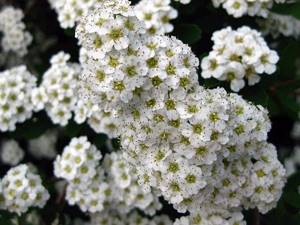
Pests and diseases
Sometimes gray spirea suffers from snails. To protect the gray spirea bush from gastropods, treat it in early spring and immediately after flowering with Fitoverm solution. From time to time, spirea is pestered by roseate leafrollers, aphids or spider mites. For aphids, the plant is treated with Actellik, Bitoxibacillin, Etafos or Pirimor, for spider mites - with Phosfamide, Karbofos or Fozalon, and for leaf rollers - with Actellik, Avant, Ditox or other preparations for leaf-eating pests.
- Choosing the right roses in a flower shop in Moscow
Due to improper care, spirea can be affected by ascochyta blight, septoria blight or ramularia blight. The infection is destroyed by treating the bush with copper-containing preparations: Bordeaux mixture or Fundazol solution, for example. Colloidal sulfur also copes well with fungi. Spraying spirea with fungicides is carried out before or after flowering.
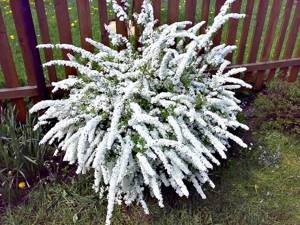
Trimming
The method and time of pruning spirea depend on the shoots of which year inflorescences form. When to prune gray spirea? Since the flowers of the plant are formed along the entire length of the shoot, it would be advisable to trim the spirea with sulfur after flowering.
To reduce the size of the bush and increase its density, spirea shoots are shortened. The main pruning consists of removing old and dry branches that reduce the decorativeness of the plant. Every year in the spring, branches and shoots that have frozen over the winter are cut out. Rejuvenating pruning of spirea begins at the age of seven: for this purpose, gray spirea is cut to the stump, which stimulates the awakening of dormant buds located at the root collar. They produce young shoots, from which they form a new bush: they leave 5-6 of the strongest shoots, and cut out the rest in the first growing season. Then, every 2 years, weak and aged branches are removed. Bush-forming pruning is carried out in early spring, before the buds begin to open. Sanitary cleaning, as we have already written, is carried out after the flowering of spirea sulfur.
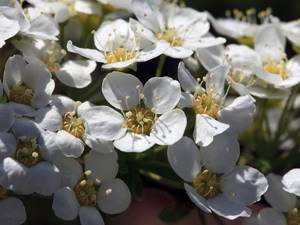
Spiraea gray after flowering
Gray spirea exhibits winter hardiness even in the harshest winters. Problems can arise only when temperature fluctuations occur during the winter, and frosts are abruptly replaced by thaws. In such winters, it is better to cover the root zone of spirea. The underground part of young plants also needs protection from frost, the tree trunks of which should be mulched in the fall with a thick layer of dry foliage or peat.
How to prune late-blooming spirea correctly
Late flowering shrubs should be pruned in late summer. Small and weakened branches are completely removed, and the main ones are cut down to the largest bud. Don't be afraid to rejuvenate the bush: the more you cut, the better the new branches will be. Otherwise, they dry out and die. When pruning spirea older than 4 years, complete rejuvenation is necessary: the bush is cut to a height of 25-30 cm. If after this procedure the plant develops poorly, then it should be replaced. Typically, such a shrub lives for about 20 years.
Care and pruning of spirea must be carried out on time, otherwise the heavy branches will begin to lean towards the soil and dry out.
Now you know how to prune spirea.
Spiraea salicifolia
Spiraea loosestrife
grows wildly in western North America and throughout Eurasia. An upright growing shrub up to 2 meters with vertically upward shoots of a reddish-brown-yellow color, slightly faceted. The leaves are pointed, elongated, up to 10 cm, dark green on top and lighter at the bottom. Pink or white flowers are collected in narrow pyramidal or cylindrical panicles up to 20 cm long. The plant is demanding on soil, grows better in moist, fresh soils, and is frost-resistant. It gets very thick, requiring periodic cleaning. This view is very good against the background of willow, and is successfully used in group plantings.
Reproduction of spirea in spring by dividing the bush
Reproduction of spirea is carried out in several ways: by dividing the bush, seeds, layering and cuttings. The first method is considered the most optimal and fastest. We will tell you how to propagate spirea in all ways.
A quick way to get a mature plant. Spiraea is propagated by dividing the bush if the plant has reached the age of 4 years. It is divided into several smaller shrubs. If the plant is older, then this method will be extremely labor-intensive: the roots have grown and formed a powerful system. Because of this, it becomes extremely difficult to remove the bush from the ground and divide it.
This method is suitable for propagating spirea in the spring. This can be done in the summer, but not during periods of heat and drought, since new shrubs will need moist soil. Cool air and warm ground will provide the best conditions.
Dig up the bush based on the size of the crown, plus half a meter. Don't worry if you damage a few roots during this process.
The root system must be dipped in water for several hours, until part of the soil settles. Wash the remains under running water. This is necessary so that the earth does not interfere with the division of the bush into parts. Otherwise, due to carelessness, you can damage the roots or separate them unevenly, as they tend to intertwine.
Divide the bush. Each piece should have a couple of main branches and a good root system. After this, the plant needs to be prepared for planting. The roots should be made the same length and small shoots should be trimmed.
Having dug a hole, pour soil inside to form a small mound on which you need to place the new shrub. After this, distribute the roots evenly. Fill the hole with fertile soil.
Immediately after planting, the plant must be watered abundantly. If it is hot summer outside, then you need to water every day, and in cool weather - once a week. If there is enough moisture, the plant will quickly take root and will actively develop.
If the bush has outgrown the age of 4 years, then you should use other methods.
Types and varieties of spirea
Meadowsweet bushes are so diverse in their appearance, shapes and the number of hybrids that each species and variety should be described in more detail.
Spiraea white
The name Spiraea albiflora or white spirea is quite justified, due to the presence of virgin white flower stalks on it. Their appearance is more like 15-centimeter pyramid panicles.
The main habitat of this species is North America, and in Russia it can be found extremely rarely under natural conditions.
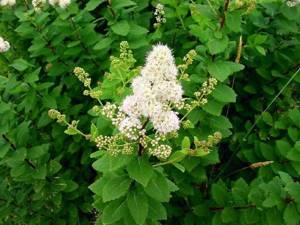
The shrub grows slowly and only after 10 years can it reach 2 m in height, acquiring a spherical shape. This is due to the flexibility of the shoots, ribbed shape and red-purple color, the location of the peduncles, which are located at the ends of the shoots.
The leaf plate has a curly shape, thanks to clearly defined serrations and quite large dimensions, 7 cm long and 2 cm wide.
In terms of flowering time, white meadowsweet can be classified as an autumn-flowering plant, since flower stalks appear towards the end of July and last until the end of August. This variety of meadowsweet is capable of producing fruits, and their appearance begins in late September or early October.
Attention! The excellent flexibility of the branches was most appreciated by landscape designers.
White meadowsweet, in their opinion, is excellent for both solitary and combined landscape projects.
White meadowsweet is not only a variety, but also a species. White-flowering shrubs also include spirea:
- Vanhoutte (Spiraea x vanhouttei);
- Nipponian (Spiraea Rainbow Girls);
- Thunberg (Spiraeathunbergii);
- gray (Spiraea x cinerea).
These varieties are united by the presence of white peduncles and the fact that they are all early-flowering spirea.
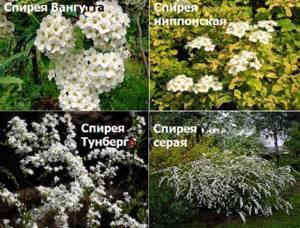
Spiraea pink
The decorative appearance of the shrub is due to its relatively short height, and we can safely say that it is a bush spirea. An adult, fully formed bush reaches 1.5 m in height and forms a crown 1.5 m in circumference. Shoots located strictly vertically can grow 20 cm in a year.
The leaf blades look like a 10-centimeter ellipse, the color of bright spring green. As the name suggests, the flower stalks are painted in soft pink tones and look like lush panicles.
Of all the variety of meadowsweet varieties, the pink one is the most resistant to low winter temperatures. This factor was the main reason for the popularity of rose meadowsweet among Siberian gardeners.
Pink-flowering shrubs, as well as white-flowering ones, include the following varieties of spirea:
- Japanese (more than 20 species);
- Macrophylla;
- willow;
- Douglas;
- Bumalda.
The Candelight spirea, which belongs to the group of Japanese miniature spireas, deserves special attention.
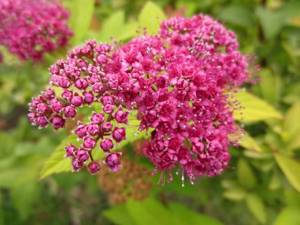
This shrub is very compact and slow growing. At the 5th year of life it reaches a maximum size of 0.5 m in height and width. The leaf blades are yellow in color with a light creamy tint; from June to August, quite large shields of pinkish inflorescences up to 8 cm in diameter stand out brightly against their background.
This type of spirea, which blooms all summer, has won respect among landscape designers. It is one of the few varieties that cope excellently with polluted urban air and severe winter frosts.
Important! Meadowsweet prefers fertile and well-drained sites.
Spiraea yellow
The name “yellow” meadowsweet is due to the color of the leaf blades of the shrub. Some species do not change it throughout the season, while in others the color of the leaf blade changes from bright yellow to fiery orange.
Yellow-leaved species include spirea:
- Goldflame;
- Gold Mount;
- Golden Princess;
- Sparkling Carpet;
- Golden Carpet;
- Valbuma (Magic Carpet);
- Fire Light;
- Golden Fountain.
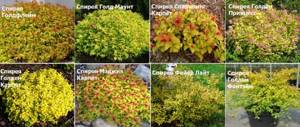
Spiraea average
Spiraeamedia or middle spirea is a tall shrub, reaching 3 m. Its natural distribution area is the Eurasian temperate zone.
The branches growing straight upward form a rounded crown. The leaf blade is slightly pubescent and resembles an elongated, pointed ellipse with jagged edges of a green-yellow color.
The average meadowsweet blooms only in the 5th year, forming white shields of flowers, evenly spaced on the branch with a distance of 3-4 cm from each other. Flowering begins in mid-May and ends by early June.
Distinctive features of this variety of meadowsweet are:
- frost resistance;
- drought resistance;
- gas resistance.
The combination of these factors allows the use of medium meadowsweet for landscaping parks, gardens and flower beds of any city and industrial enterprises.
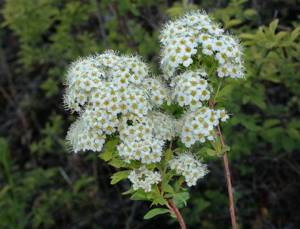
Spiraea rowan leaf
The spirea shrub received this name because of its leaf blades reminiscent of mountain ash, and sometimes people simply call this variety “rowanberry”.
At a younger age of the shrub, the color of the leaves is closer to pink, and as it matures it changes to a bright green color.
Meadowsweet blooms from June to September, with beautiful, fragrant, white pyramidal panicles up to 25 cm in length.
This species is endowed by nature with an excellent root system, which allows the bush to be planted on loose cliffs in order to strengthen the soil on the slope.
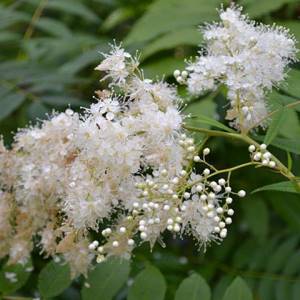
The variety of varietal forms of this species allows the shrub to be used in landscaping. In group plantings, rowan-leaved spirea looks great with euonymus, derain, weigela and conifers.
Spiraea viburnum
Judging by the name, you can immediately imagine this type of shrub. It is thanks to the similarity with viburnum leaves that this name became popular among the people. This variety of meadowsweet has up to 10 species. Several of them, in addition to viburnum-shaped leaves, form inflorescences that from a distance resemble clusters of viburnum.
The meadowsweet shrub is quite large in size and can reach 4 m in height. The decorative effect of a bush depends entirely on the color of the leaf plates, which can be:
- colors of spring green or yellow-lemon shade;
- burgundy, scarlet or orange color.
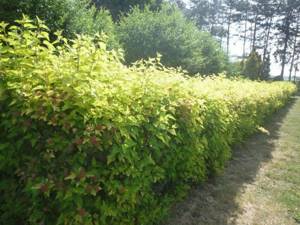
Spiraea crenate
Spiraeacrenata or crenate spirea cannot boast of high growth; at its maximum it reaches only a meter in height, while forming a rather loose crown shape. The southeast of the Russian Federation, the Caucasus region and Altai - only in the climatic conditions of these regions can meadowsweet be seen in its natural growing conditions.
The leaf blade is elongated, reaching a size of 5 cm, and is distinguished by its green color with a slight ashy coating. Sometimes, due to the similarity in the color of the leaf blades, this variety is confused with Gerstein spirea and Oakleaf spirea.
Peduncles, white with a slight yellowish tint, appear by mid-July for only 3 weeks in the form of a small umbrella.
This plant rarely appears on personal plots, but for landscape designers, meadowsweet has become a godsend.
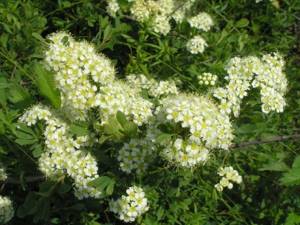
Important! When choosing a site for planting shrubs, you should give preference to well-lit places or light partial shade.
Spiraea Japanise Dwarf
This variety of shrub belongs to the border spirea, since even in adulthood the plant’s growth does not exceed 30 cm.
The flower stalks are pale pink in color and are located at the tops of the branches. The shrub is capable of producing its first flowers by mid-June, and by the end of July the small saucer-shaped flower stalks disappear.
Only in the fall does the leaf blade of the bush change from a “green dress” to an “orange sundress.” It was this feature that made it possible to draw the attention of landscape designers to the Japanese Dwarf bush.
The same ability to change the color of the leaf blade is present in Magnum Rose spirea. But it is impossible to confuse them with each other, since the Magnum Rose shrub is not short-growing, its growth reaches 120 cm in height, and the Japanese Dwarf shrub can be described as a creeping spirea.
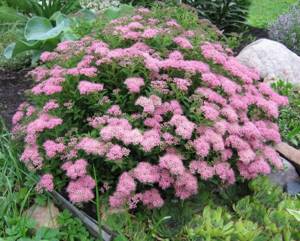
Spiraea Manon
The beauty of the compact Manon meadowsweet shrub lies in the varied colors of the leaf blade. The bush is quite small in height and width, 80 and 60 cm, respectively. Throughout the season, the color of the leaves can change:
- blossoming, the leaves turn reddish;
- in summer the color changes to emerald green;
- in autumn the leaves become covered with a red-orange purple.
Meadowsweet Manon can be classified as an autumn-flowering variety, since the pale pink shields of the inflorescences delight the eye throughout the summer and autumn months. The shields are located on the tops of the branches, which gives the bush a regular rounded shape, and from a distance it looks like a pink ball.
Gardeners have noted a great similarity in size, color of leaves and peduncles between the spirea Zigunerblut and Manon. This sometimes leads to some confusion.
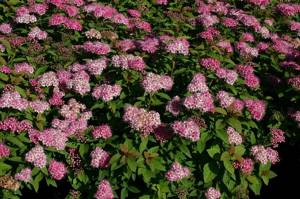
Spiraea dense-flowered
Meadowsweet received this name because of the dense and rather large shields-inflorescences of pink color, capable of reaching 10-12 cm in diameter. The shrub itself is not very tall and can grow only 80 cm, while the diameter of the crown will be at least a meter.
By autumn, the color of the leaf blades changes from emerald green to fiery orange.
A type of densely flowered meadowsweet includes the variety of Japanese multi-colored spirea Shirobana, which has dense shields of two-color inflorescences.

Spiraea Sparkling Champagne
A relatively short shrub of this variety is capable of decorating a garden with almost all the colors of the rainbow throughout the growing season. In spring, the leaf blade is painted in red-pink tones, which become similar to the color of lime closer to summer. The flower stalks look like small clusters located at the ends of the branches and last throughout the summer.
The growth of the shrub does not exceed 80 cm, and because of this it has gained popularity among landscape designers.
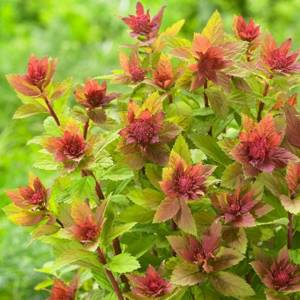
Spiraea Cantonica
This shrub can grow up to 180 cm. But the main beauty lies in the drooping branches that can form a spherical crown. In June, Cantonese meadowsweet looks like a snow-white ball, thanks to the lush, medium-sized shields of peduncles.

Spiraea redleaf
The Frobeli shrub, which is most often called red-leaved meadowsweet, can boast of the red color of its leaf blades.
In the spring, the leaf plate is painted purple mother-of-pearl, in the summer it changes color to diamond green, and by autumn the foliage is transformed; from afar, the bush looks like a burning fire.
The bush blooms throughout the summer and in September, covered with crimson-colored peduncles.
Important! The shrub needs pruning, both rejuvenating and sanitary.
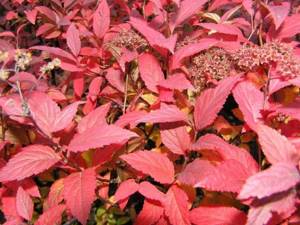
Spiraea serrata
The shrub got its name because of the beautiful shape of the carved leaf plates - the edges of the elliptical leaves have clearly defined serrations. Most often it is called "Argutta". The shrub is tall, capable of reaching 200 cm in height and 300 cm in width. And drooping branches with snow-white peduncles make the bush look like a waterfall. Sometimes Argutta is confused with columbine spirea due to the similarity of branches and color of peduncles.
Spiraea Pink Spuckler can also be classified as sharp-toothed, since its leaf blade is very similar to the leaves of Argutta.

Spiraea paniculata
A tall shrub, capable of reaching 200 cm in height, is extremely beautiful during flowering. The lilac flower stalks that appear in spirea look like large panicles up to 20 cm in height, which was the reason for the name “paniculate”.
Paniculate inflorescences have many spirea, whose peduncles vary in inflorescence color - white, pink or lilac. These include Billard's meadowsweet and willow meadowsweet.
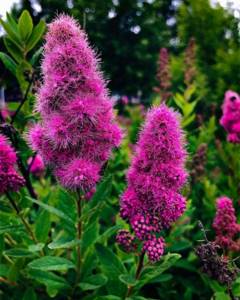
Spiraea June Bride
The shrub belongs to the Nippon spirea variety. Sometimes in descriptions you can find the name of the shrub as “spirea Junia Bright”.
The bush is medium, reaching 150 cm in height and diameter. Two-color leaf plate:
- on top - the color of rich green;
- below – smoky-ashy shade.
Peduncles appear in the spring in the second decade of May and remain on the bush until mid-June, decorating the bush with small shields of milky flowers.
Meadowsweet June Bride is resistant to air pollution and is able to decorate any garden area with its presence. An important factor is the shade tolerance of the spirea of this variety.
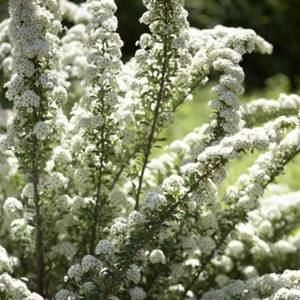
Spiraea Mount
The shrub called "Mount" is more popular under the name "Gold Mount". This name was given to the plant because of the color scheme of the leaves, which can change color depending on the planting location:
- in sunny areas the color is golden and yellow;
- in the shade the foliage turns only emerald green.
Despite its miniature height, which does not exceed 60 cm, the plant has a rather chic cushion-shaped crown, reaching 120 cm in diameter. Regardless of the planting location, by autumn the leaf blade changes color to fiery red.
Pale pink flower stalks appear in July, and by October the shrub enters the fruiting phase.
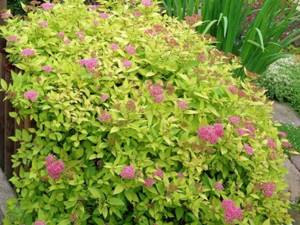
Spiraea Neon Flash
A shrub 90 cm high is capable of changing the color of the leaf plate three times per season:
- In spring the color is closer to red.
- In summer it turns emerald green.
- In autumn it plays with red crimson.
Peduncles delight the eye throughout the summer, and after formative pruning, Neon Flash meadowsweet is able to show new shield-shaped inflorescences of a fiery red color by the end of September.
Important! The shrub is quite drought-resistant and requires moderate watering.
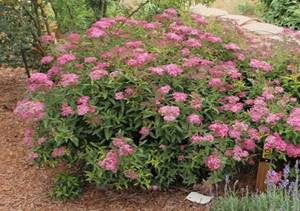
Spiraea dwarf
The shrub is a hybrid that was obtained by crossing Spira Hacket and creeping. The height of the plant never exceeds 0.3 m and is considered a ground cover. Of all the variety of varieties and species, dwarf meadowsweet is the only variety of such low growth.
Despite all its attractiveness, this plant has not become widespread and popular among gardeners.
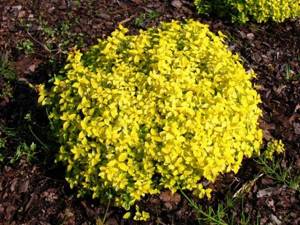
Spiraea St. John's wort
Meadowsweet is one of the tallest shrubs of this family, capable of growing up to 3 m in height. For the similarity of the leaf blades with St. John's wort, the plant was given this name. The shrub blooms for only 15 days, starting in May, with white, rather small flowers located along the entire length of the branches.
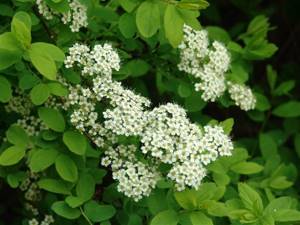
Spirea Country Red
The shrub belongs to the species of Japanese spirea, no more than 80 cm in height. The entire growing season, the leaf blade remains painted in dark tones of green, and by autumn it changes its “green outfit” to a fiery orange “dress”. The prefix “Red” in the name does not mean that the shrub has a predominant color of red, but the closest thing to this color scheme is the large shields of peduncles that appear and do not disappear all summer.
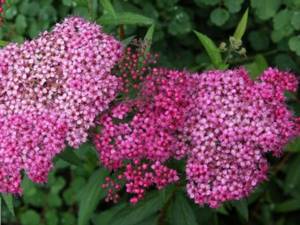
Spiraea Fujino Pink
Most often, the prefix “Thunberg” can be found in the name of this shrub. Meadowsweet Fujino Pink attracts attention with drooping branches and changing color of peduncles - from pink to snow-white. The maximum height is 150 cm, with a mandatory size of 200 cm in crown diameter. Meadowsweet Fujino Pink tends to change leaf color throughout the season:
- spring – greenish-yellow;
- summer – bright green;
- autumn – fiery red.
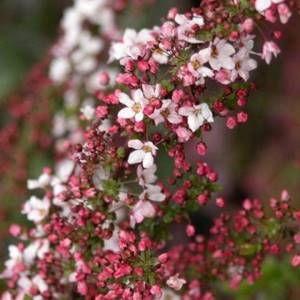
Spiraea densiflora
Meadowsweet Densiflora is a type of densely flowered spirea. The shrubs are exactly alike in their shoots, leaf blades, shape and size of peduncles. The only difference between them is the color scheme of the emerging inflorescences - in the Densiflora meadowsweet they are virgin white, for which the people nicknamed the shrub “bride”.

Spiraea triloba
The decorative appearance of three-lobed meadowsweet is given by leaf plates that look like 3 fused figured lobes, painted smoky green underneath. The bush is covered with small white shields for 15 days, starting in mid-June, and at the end of September the fruits ripen on the branches.
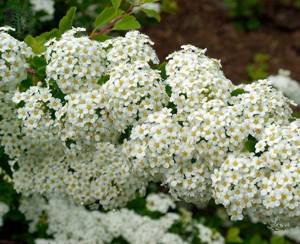
How to propagate spirea by seeds
This method is suitable for all varieties except hybrid ones. They reproduce by cuttings or layering.
Wide and low containers are best suited for propagating spirea shrubs by seeds. Fill them with peat and fertile soil at a ratio of 1:1. After planting, the seeds must be “covered” with the same mixture with a layer of 1 cm.
The plant will begin to break through the ground after 9-10 weeks.
To prevent the development of diseases in seedlings, they must be treated with foundationazole or a regular solution of potassium permanganate.
After 2-3 months, the shrubs can be planted in their permanent place of residence. After this, they need to be watered abundantly and mulched, for example, with peat. It is worth expecting flowering in the 4th year of cultivation.
Reproduction of spirea shrubs by layering
This method of propagation is suitable for the spring period. The shoots that are located lower than the others must be bent to the ground and secured with pins. Cut the end of the branch and sprinkle it with fertile soil along the entire length.
Rooting occurs throughout the year. In winter, to protect the shoot from low temperatures, it must be covered with fallen leaves. After the new bush has taken root, the branch is cut off from the main bush and planted in the required location. To make the foundation process faster, the bark on the shoot needs to be trimmed a little.
Spiraea chamaedryfolia
Spiraea oakleaf
An erect shrub that grows up to 2 meters high, with long ribbed shoots that curve beautifully to the ground. The leaves are 3.5-4.5 cm long, ovate, bright green above, bluish below. Large (up to 1.5 cm) white flowers in hemispherical inflorescences. Blooms profusely for 25 days from the beginning of May. The plant is very frost-resistant, tolerates slight shade, tolerates urban conditions well and lends itself well to pruning. In autumn the leaves are colored yellow. The shrub is widespread in northeastern Europe, Central Asia, Siberia, and the Far East.
Reproduction of spirea in spring by cuttings (with photo)
Cuttings are one of the least labor-intensive methods for this shrub. Propagation of spirea by cuttings is available for any variety, including hybrids.
After the end of active growth of shoots, you can begin cuttings. For early-flowering shrubs, cuttings are cut in late spring, and for late-flowering shrubs, in mid-summer.
Select suitable containers and fill them with a mixture of peat and sand. Place the cuttings in them. To make the plant take root faster, it should be watered 4-5 times a day or install mist watering.
The plant has good survival rate. However, when using a root growth stimulator, the chances of rooting will reach a maximum. Next year the cuttings can be moved to their permanent place in the garden.
Propagation of spirea by cuttings in the spring will produce the healthiest and strongest shoots.
Look at the photo of spirea propagation:
Diseases and pests of spirea
As a rule, the bush gets sick very rarely. However, sometimes it can be attacked by harmful insects.
Spider mite
It is one of the most dangerous. The leaves will help you notice the appearance of this pest: they are covered with small whitish spots. After which, the leaves die. Most often, spider mites can be found in hot summers, especially during dry times.
To get rid of this pest, it is necessary to treat the plant with arex solution or fozalon.
Aphid
Capable of causing no less damage than a tick. It feeds on the sap of the plant, which leads to its gradual withering.
To combat aphids, you can use solutions of pyrimor or kronefos.
If a small part of the plant is affected, then you can get by with folk remedies: tinctures of capsicum, onion or tobacco.
In addition to dangerous insects, the bush can also be attacked by a fungal infection, such as gray mold. To cure such a disease it is necessary to use Bordeaux mixture. However, if the plant is severely affected, it cannot be cured.
Fungal infections can spread to other shrubs, so an infected plant must be treated as soon as possible.
